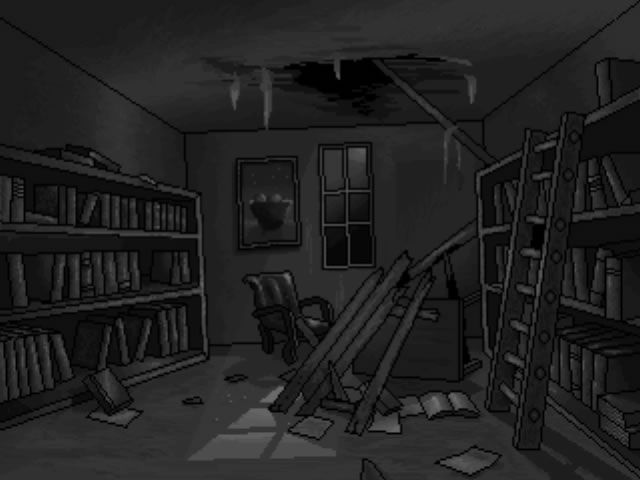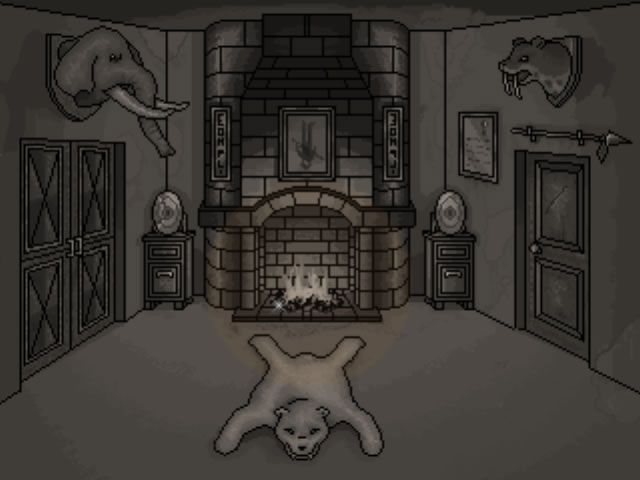Retro Replay Review
Gameplay
Speculum Mortis embraces the classic point-and-click formula, relying entirely on mouse-driven controls. A left-click lets you examine objects and areas in the environment, revealing subtle clues or descriptive text that deepen the atmosphere. A right-click interacts with elements—opening doors, picking up items, or triggering hidden mechanisms. This simplicity keeps the focus squarely on exploration and puzzle-solving rather than mastering complex control schemes.
(HEY YOU!! We hope you enjoy! We try not to run ads. So basically, this is a very expensive hobby running this site. Please consider joining us for updates, forums, and more. Network w/ us to make some cash or friends while retro gaming, and you can win some free retro games for posting. Okay, carry on 👍)
The game limits your inventory to just four slots, enforcing careful decision-making about which items to carry. Although you’ll never need to combine objects, each tool or trinket you pick up serves a distinct purpose in unlocking new sections of the estate. Because there are no NPCs to hand you hints or drive sidequests, the environment itself becomes both your guide and your adversary: you’ll scour every nook and corridor for the key items that will set you free—or doom you to an untimely demise.
Puzzles range from environmental riddles to logic challenges, often requiring trial-and-error and keen observation of shifting scenery. Death is always a possibility—misstep in a shadowy hall, ignore a subtle hazard, and you could find yourself restarting from your last checkpoint. While some players may find the occasional instant-kill frustrating, it heightens the tension and delivers genuine chills, making each successful escape feel hard-won and immensely satisfying.
Graphics
Speculum Mortis presents its world almost entirely in grayscale, punctuated only by strategic splashes of gold and red. This muted palette amplifies the sense of decay and dread permeating the old estate’s halls. The selective use of color draws your eye to interactive elements or lurking dangers, reinforcing puzzle objectives without resorting to intrusive UI markers.
The estate’s architecture is rendered with impressive detail: crumbling stone archways, warped wooden floorboards, and ornate ironwork gates all contribute to a convincing, gothic setting. Subtle particle effects—floating dust motes, flickering candlelight, drifting fog—lend a cinematic quality to each room. Even in stillness, the environments feel alive, as though the shadows themselves might shift when you’re not looking.
User interface elements remain deliberately minimal, letting the environments shine without clutter. Hotspots highlight when you hover the cursor, maintaining immersion while ensuring you won’t miss important interactive points. The inventory screen is clean and straightforward, with small icons that clarify each item’s purpose. Any occasional glitch—like an overly sensitive hotspot or a slight texture pop-in—feels minor against the backdrop of the game’s visceral visual style.
Story
At its heart, Speculum Mortis tells a simple yet compelling tale: a weary traveler on a late-night drive through Middle-English countryside offers a ride to a mysterious young woman. The pair pull up to a sprawling estate, but once inside the gates slam shut, the hitchhiker vanishes without a trace. From that moment on, every creak of the floorboards and distant whisper keeps you on edge, driving your need to uncover what lurks within those walls.
Narrative unfolds almost entirely through environmental storytelling. Faded letters, cryptic symbols etched into walls, and fragmented diary entries hint at the estate’s dark history—and perhaps the identity of the girl you picked up. With no other characters to interact with, the story’s weight rests on your interpretation of these clues. This minimalist approach deepens the mystery but also demands patience and close reading of every text fragment and audio cue.
The game’s pacing mirrors its setting: deliberate and slow-burn. Early moments build suspense as you search empty corridors; midway, small revelations ratchet up tension; and in the finale, collected clues coalesce into a stark, haunting payoff. While some may wish for more direct exposition or character interactions, others will appreciate the unrelenting ambiance and the satisfaction of piecing together the narrative puzzle on their own.
Overall Experience
Speculum Mortis offers a uniquely immersive journey for fans of atmospheric horror and classic adventure gaming. Its stark visual style, haunting sound design, and meticulously crafted puzzles combine to create an experience that lingers long after you’ve turned off your computer. The tension of possibly dying around every corner keeps every moment charged, and the lack of hand-holding rewards those willing to explore thoroughly.
Expect to spend anywhere from two to four hours navigating the estate, depending on how quickly you solve the puzzles and interpret the clues. While there’s limited replay value once you know every secret passage, the core experience is tight and focused—free from filler or superfluous side content. Any frustrations—such as the occasional trial-and-error death or a stubbornly hidden hotspot—feel like part of the game’s old-school charm rather than design oversights.
In sum, Speculum Mortis is a consummate example of modern indie horror that pays homage to the point-and-click adventures of yesteryear. Its haunting atmosphere, clever puzzles, and minimalistic storytelling deliver a memorable, if brief, trip through a decaying manor and your own creeping dread. For players seeking a slow-burn mystery with genuine stakes and no NPC distractions, this estate’s gates are waiting to trap—and enthrall—you.
 Retro Replay Retro Replay gaming reviews, news, emulation, geek stuff and more!
Retro Replay Retro Replay gaming reviews, news, emulation, geek stuff and more!








Reviews
There are no reviews yet.